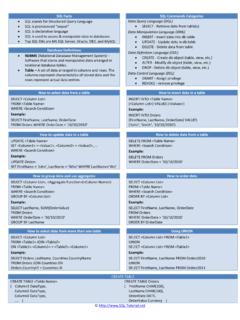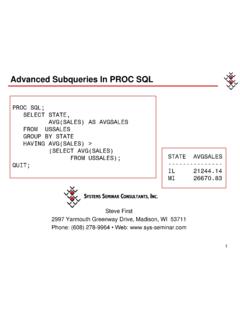Transcription of SQL - tutorialspoint.com
1 SQL i SQL i About the Tutorial SQL is a database computer language designed for the retrieval and management of data in a relational database. SQL stands for structured query language . This tutorial will give you a quick start to SQL. It covers most of the topics required for a basic understanding of SQL and to get a feel of how it works. Audience This tutorial is prepared for beginners to help them understand the basic as well as the advanced concepts related to SQL languages. This tutorial will give you enough understanding on the various components of SQL along with suitable examples. Prerequisites Before you start practicing with various types of examples given in this tutorial, I am assuming that you are already aware about what a database is, especially the RDBMS and what is a computer programming language .
2 Compile/Execute SQL Programs If you are willing to compile and execute SQL programs with Oracle 11g RDBMS but you don t have a setup for the same, do not worry. Coding Ground is available on a high-end dedicated server giving you real programming experience. It is free and is available online for everyone. Copyright & Disclaimer Copyright 2018 by Tutorials Point (I) Pvt. Ltd. All the content and graphics published in this e-book are the property of Tutorials Point (I) Pvt. Ltd. The user of this e-book is prohibited to reuse, retain, copy, distribute or republish any contents or a part of contents of this e-book in any manner without written consent of the publisher. We strive to update the contents of our website and tutorials as timely and as precisely as possible, however, the contents may contain inaccuracies or errors.
3 Tutorials Point (I) Pvt. Ltd. provides no guarantee regarding the accuracy, timeliness or completeness of our website or its contents including this tutorial. If you discover any errors on our website or in this tutorial, please notify us at SQL ii Table of Contents About the Tutorial .. i Audience .. i Prerequisites .. i Compile/Execute SQL Programs .. i Copyright & Disclaimer .. i Table of Contents .. ii 1. SQL Overview .. 1 What is SQL? .. 1 SQL Process .. 2 SQL Commands .. 3 2. SQL RDBMS Concepts .. 5 What is RDBMS? .. 5 SQL Constraints .. 6 data Integrity .. 7 Database Normalization .. 7 Database First Normal Form (1NF) .. 8 Database Second Normal Form (2NF).
4 10 Database Third Normal Form (3NF) .. 11 3. SQL RDBMS Databases .. 14 MySQL .. 14 MS SQL Server .. 15 ORACLE .. 16 MS ACCESS .. 17 4. SQL Syntax .. 19 Various Syntax in SQL .. 19 5. SQL data Types .. 24 6. SQL Operators .. 28 What is an Operator in SQL? .. 28 SQL Arithmetic Operators .. 28 Arithmetic Operators Examples .. 29 SQL Comparison Operators .. 30 Comparison Operators Examples .. 31 SQL Logical Operators .. 34 Logical Operators 35 7. SQL Expressions .. 41 Boolean Expressions .. 41 Numeric Expressions .. 42 Date Expressions .. 43 8. SQL CREATE Database .. 45 9. SQL DROP or DELETE Database .. 46 10. SQL SELECT Database, USE Statement .. 47 SQL iii 11.
5 SQL CREATE Table .. 48 SQL - Creating a Table from an Existing Table .. 49 12. SQL DROP or DELETE Table .. 51 13. SQL INSERT query .. 53 14. SQL SELECT query .. 56 15. SQL WHERE Clause .. 59 16. SQL AND & OR Conjunctive Operators .. 62 The AND Operator .. 62 The OR Operator .. 63 17. SQL UPDATE query .. 66 18. SQL DELETE query .. 69 19. SQL LIKE Clause .. 72 20. SQL TOP, LIMIT or ROWNUM Clause .. 76 21. SQL ORDER BY Clause .. 79 22. SQL Group By .. 82 23. SQL Distinct Keyword .. 86 24. SQL SORTING Results .. 89 25. SQL Constraints .. 92 SQL - NOT NULL Constraint .. 92 SQL - DEFAULT Constraint .. 93 SQL - UNIQUE Constraint .. 94 SQL Primary 95 SQL Foreign Key.
6 96 SQL CHECK Constraint .. 98 SQL INDEX Constraint .. 99 Dropping Constraints .. 101 Integrity Constraints .. 101 26. SQL Using Joins .. 102 SQL - INNER JOIN .. 103 SQL LEFT JOIN .. 105 SQL - RIGHT JOIN .. 107 SQL FULL JOIN .. 109 SQL SELF JOIN .. 111 SQL CARTESIAN or CROSS JOIN .. 113 27. SQL UNIONS CLAUSE .. 116 The UNION ALL Clause .. 119 SQL INTERSECT Clause .. 121 SQL EXCEPT Clause .. 123 SQL iv 28. SQL NULL Values .. 127 29. SQL Alias Syntax .. 130 30. SQL Indexes .. 134 The CREATE INDEX Command .. 134 The DROP INDEX Command .. 135 SQL - INDEX Constraint .. 135 31. SQL ALTER TABLE Command .. 138 32. SQL - TRUNCATE TABLE Command .. 142 33. SQL Using Views.
7 143 Creating Views .. 143 The WITH CHECK OPTION .. 144 34. SQL Having Clause .. 148 35. SQL Transactions .. 151 Properties of Transactions .. 151 Transactional Control Commands .. 151 36. SQL Wildcard Operators .. 158 37. SQL Date Functions .. 162 38. SQL Temporary Tables .. 192 What are Temporary Tables? .. 192 Dropping Temporary Tables .. 193 39. SQL Clone Tables .. 194 40. SQL Sub Queries .. 197 Subqueries with the SELECT Statement .. 197 Subqueries with the INSERT Statement .. 198 Subqueries with the UPDATE Statement .. 199 Subqueries with the DELETE Statement .. 200 41. SQL Using 202 Using AUTO_INCREMENT column .. 202 Obtain AUTO_INCREMENT Values .. 203 Renumbering an Existing Sequence.
8 203 Starting a Sequence at a Particular Value .. 204 42. SQL Handling Duplicates .. 206 43. SQL Injection .. 209 Preventing SQL Injection .. 210 SQL 1 SQL is a language to operate databases; it includes database creation, deletion, fetching rows, modifying rows, etc. SQL is an ANSI (American National Standards Institute) standard language , but there are many different versions of the SQL language . What is SQL? SQL is structured query language , which is a computer language for storing, manipulating and retrieving data stored in a relational database. SQL is the standard language for Relational Database System. All the Relational Database Management Systems (RDMS) like MySQL, MS Access, Oracle, Sybase, Informix, Postgres and SQL Server use SQL as their standard database language .
9 Also, they are using different dialects, such as: MS SQL Server using T-SQL, Oracle using PL/SQL, MS Access version of SQL is called JET SQL (native format) etc. Why SQL? SQL is widely popular because it offers the following advantages: Allows users to access data in the relational database management systems. Allows users to describe the data . Allows users to define the data in a database and manipulate that data . Allows to embed within other languages using SQL modules, libraries & pre-compilers. Allows users to create and drop databases and tables. Allows users to create view, stored procedure, functions in a database. Allows users to set permissions on tables, procedures and views.
10 A Brief History of SQL 1970 Dr. Edgar F. "Ted" Codd of IBM is known as the father of relational databases. He described a relational model for databases. 1974 structured query language appeared. 1978 IBM worked to develop Codd's ideas and released a product named System/R. 1. SQL Overview SQL 2 1986 IBM developed the first prototype of relational database and standardized by ANSI. The first relational database was released by Relational Software which later came to be known as Oracle. SQL Process When you are executing an SQL command for any RDBMS, the system determines the best way to carry out your request and SQL engine figures out how to interpret the task.
















